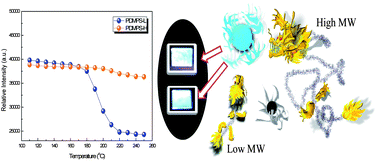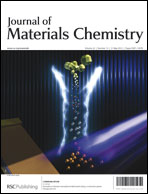Influence of molecular weight on the aggregation-induced emission enhancement and spectral stability of vinyl polymers containing the fluorescent 2,4,6-triphenylpyridine pendant groups†
Abstract
The effect of molecular weight on the aggregation-induced emission enhancement (AIEE) and the spectral stability of vinyl polymers containing fluorescent 2,4,6-triphenylpyridine (TP) pendant groups was evaluated in this study. The high and low molecular weight (MW) vinyl polymers of PDMPS-H and -L are deep-blue emitters with the respective high quantum yields of 82.5 and 84.1% in the solid film state. With high MW (Mn = 525,400 g mol−1), PDMPS-H also possesses high spectral stability without reduction in the emission intensity upon heating to temperatures above 200 °C. Solutions of the low MW (Mn = 37,300 g mol−1) PDMPS-L exhibited the normal AIEE effect with continuous emission gains with increasing aggregation upon nonsolvent inclusion. In contrast, the high MW PDMPS-H solutions emitted with constant intensity on all solutions with different extent of aggregation. The emission behavior was then explained by the conformational difference between the PDMPS-L and -H chains and was theoretically approached by computer simulation.


 Please wait while we load your content...
Please wait while we load your content...